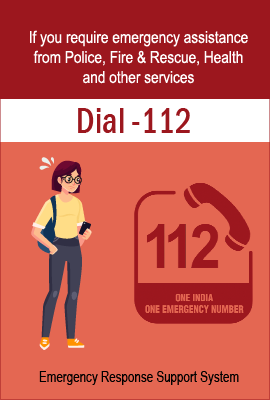ABOUT
Cheemeni Police Station

Cheemeni Police station was opened as per GO(MS) No 72/88 Home dtd. 17.06.1988 in KCP VIII/441 and later on 7.06.1992 the station building was shifted to the present building. 4 flat type quarters are available for the accommodation of the police personnel. Cheemeni police station is the byproduct of the cold blooded massacre that occurred at CHEEMENI town during1987 The 9’th election to the General Assembly was held on 23.03.1987. For the smooth conduct of election Chandera Police station was divided in to 3 groups, VIZ Group No.24,25 and 26 of which group No.26 consisting of Kayyur and Cheemeni villages. Though kayyur village actually belongs to Nileshwar police station limits, for election convenience it was included in Group No. 26 of Chandera Police station.
Though the poling was started at 08.00 hrs no untoward incidents were reported from the group area till 16.30 hrs. Polling was very smooth in all places including at Cheemeni and kayyur. But at 16.30 hrs some Con(I) workers including one Plantholi Krishnan went to kayyur in a jeep to pick their polling agents from the booth. Being a party village(Gramam) of the CPI(M), annoyed by this they way laid and assaulted them. The congress (I) worker Plantholi Krishnan was stabbed and he succumbed on the spot. This sensitive news regarding the murder at Kayyur spread like a wild fire and the congress workers assembled at Cheemeni town which is considered to be their strong holds in the locality. The congress (I) sympathizers and some anti social elements on hearing the sensitive information of murder at kayyur they without clarifying it rushed towards the CPI(M) office at Cheemeni town with deadly weapons pelted stone continuously towards the office. At that time there were about 40 party workers present near the office engaged in tabulation work. The sudden provocation from the congress (I) workers stunned the CPI(M) sympathizers . They took refuge in the office and shut down the doors and windows of the office. But among the aggrieved congress (I) workers, some extreme goonda elements collected some dry grass from the nearby place and set fire the office after pouring petrol. Though the inmates of the office due to congestion and suffocation tried to escape from the building, the anti social elements waited outside with deadly weapons like knife and sword. They chopped and stabbed the inmates and 5 CPM workers brutally murdered on the spot. They were Alavalappil Ambu, Kunhappan, C.Koran, M.Koran and Kunhikannan. All of the above happened within few minutes. In this connection, a case in Cr.No. 22/87 U/s 143,147,148, 324,436, 307,302 r/w 149 IPC was registered on the complaint of one Chevalankakkat Babu, who was an injured in this incident. After the incident a strong police pickets has been arranged at Cheemeni and nearby places. As a retaliation of the above incident, violent incidents were reported at various places like cheruvathur, Thimiri, Chebrakanam etc. places. The above incidence of violence necessitated the formation of a new Police station at Cheemeni. Cheemeni Police station comprising of 5villages Viz Kayyur,Cheemeni, kodakkad, Thimiri and a part of Pilikode having a population of 34255 as per 2011 census. Most of the people are agriculturists. Paddy, arracunets and coconuts are their main cultivation. The village of kayyur occupies an important place in the history of freedom struggle. The Village of kayyur situates on the banks of the Thejaswini river . During the British rule pattom( issuing land on Rent ) on land was very high. There was no uniformity in the collection of tax. A portion of yield was collected as tax. Most of the cultivable lands were under the land lords (Janmies) especially under the Nileswaram Thampuran. These land lords and their henchmen monopolized the land under the supervision of the British. They always exploited the tenants ( Kudiyans). In addition to the actual levies they were forced to pay various levies during festivals like Onam, Vishu etc. If anybody failed to do so, the karyasthans of the land lords at once tie a green leaf on the door of the house of such tenant and for opening that door the tenant has to go to the land lords with apology. There was no school at kayyur during that period. People are illiterate and ignorant. The pattelar (Village officer) and Ugrani (Village man) were the top Government servants of the locality at that time. They always belong to aristocratc family.They were the agents of the land lords and British Government. Any protest against the land lords were suppressed by police and civil authorities. Mean while in 1938 an organization of the peasants by name “karshaka Samgam” was formed at north Malabar and as part of this a branch of the same was formed at klayikode in kayyur village. It was strengthened day by day. Following this a branch of karshaka sangam was also formed at kayyur also. In addition to this a committee of Indian National Congress and Bhalabharatha sangam was also formed at kayyur. Adult education and party classes were also imparted through vayana salas.( Libraries.). Patriotism and anti landlordism were injected in the nerves of the downtrodden poor peasants of the locality. All these activities were viewed with contempt with land lords and their men. In the year 1939 a long march was conducted to present a memorandum to the District collector Mangalore since it belongs to kasaragod Taluk of South Canara District, for extending tenancy legislation to Kayyur Village also.
At that time a leftist movement emerged in the kerala Pradesh congress committee and they decided to give training to volunteers. In this juncture the socialists in the congress became communists and two cells were formed in kayyur village one at klayikode and other at kayyur. Corner meetings and processions were organized in deferent parts of the villages under the communists against landlordism and British rule. When the Second World War brocks out in the year 1939, the Governmrnment and civil authorities forced the youths to join army. Due to the resentment against the British rule Karshakasangam under communists opposed this and conducted protest meetings and processions against the British rule. On 12.03.1941 the Karshakasangam conducted a procession against the suppressive rule of the British with slogans “let British rule perish” ( British baranam thulayatte), Let landlordism perish (Janmittam thakaratte) ,Do not pay rent, (pattam kodukkaruthu) etc. this procession was noticed by the Revenue inspector of Nileshwar and he in turn reported the matter to the SI of Police Hosdurg and conveyed the names of some comrades. Based on the information, SI registered a case against these persons. Following this case the District Magistrate issued 6 warrants against TV Kunhambu and 5 others. On march 26 ,1941 , PC 409 Govindan of Hosdurg Police station from Chandera out post went to kayyur to inform the Pattel about the warrant and ascertained their where about. The SI had informed the PC that he would come to kayyur at midnight to arrest the accused. The Police constable slept on the Varanda of the house of Pattel. On the night he was attacked by some body and the village man who was also in the waranda along with the Police Constable misunderstood the culprit as Madathil Appu.At about 03.00 hrs SI along with PC 97 Subbaraya reached kayyur and hearing about the attack against the Police rushed to the shop of madathil Appu and those who were sleeping in the varantha of the shop were manhandle brutally . TV Kunhambu and TV Kunhi Raman were arrested from kayyur and they were brought to Hosdurg. The news of the arrest of their comrades spread like a wild fire though out Kayyur and the communist party and karshaka sangam decided to hold a protest meeting and procession on March 28 1941 against the arrest. In the midnight of 27’th March HC 224 AJ D’suosa reached the house of Pattel on the report regarding the death of one Koran at kayyur. When he reached the house, PC 97 Subbaraya was also found present in the house of pattel. Though after the inquest PC 224 left the place, Subbaraya and Pattel made their attempt to trace out the warrantees mentioned above. On 28’th march 1941on the day of protest meeting, the members of Karshakasangam and communists assembled at pookandam and conducted the procession to Kayyur shuting anti war slogans. When they reached at Edathil Kadavu near Cheriyakkara, they happens to see Police constable Subbaraya. There are two versions about the unfortunate incidents occurred at Edathil kadavu. According to the version of peasants , when the procession was going on the police constable under the influence of alchahole stood in front of the procession, abused with filthy languages. The karshaka sangam members who identified the constable as he was one of the member who lathichaged the workers few days before. Youngsters of the procession compelled him to join the procession after holding the flag. Though he walked some distance in front of the procession, he turned towards the workers and beaten them with the flag stick. The workers in turn manhandled him and finding no other way he at last reportedly jumped in to the river. Since he could not swim due to weight of the uniform and excess consumption of liquor, he breathed his last in the water.
The second version is that when the procession reached in front of the shop of one Mundavalappil Abdulla, PC97 Subbaraya was found sitting inside the shop to discharge his official duty. On seeing him inside the shop the members of the procession due to their grudge caught hold off him and entrusted the flag of karshaka sangam by force. When the procession reached near Edathil Kavu the constable reportedly thrown the flag and ran away from the spot. The volunteers chased him and finding no other way jumped in to the river. The volunteers on the other hand pelted stones towards him and at last he drowned in the deep waters of karyamgod river at kayyur. Whatever it may be the versions body of Subbaraya was floted in the waves of Thejaswini river. Forest guard Ramanna Naik reported the incident at Hosdurg police station and a case in Cr.No.35/41 was registered in this regard.
Following this MSP and Armed Reserve Police camped at kayyur and conducted raid all over kayyur village and suburbs. The incident was followed by the so called “Police Raj’ in kayyur, Kinavoor, Klayikode areas. The natives of kayyur took refuge in the nearby place. The case was registered against 61 persons. All the political activities were suppressed. All the accused were arrested and the case was charge sheeted on 14.04.1941 against 60 accused. EK Nayanar was deleted while submitting charge sheet and the court assigned the number as sc 44/41. Sessions court South Canara pronounced the judgment on 09.02.1942. 75 witnesses were examined in this case. L.B Parthasarathy was the session’s judge. In the judgment A1,A12, A31, and A51 were sentenced to death. The case of A32 was referred to Government u/s 27 of the Madrass Children Act. A26 and A46 were directed to be sent to a senior certified school for 3 years. 23 accused were acquitted and the remaining were convicted for 2 years and 3 years. Though appeals and mercy petitions were sent, all ended in vain. On 29.03.1943 the four accused( commreds) were hanged to death between 6 AM to 6.30 AM at Central jail Kannur.
Now the main political parties of Cheemeni Police station limits are CPI(M) and Con(I). Though the presence of IUML and CPI are also visible in some areas. There is no law and Order issues at present in the Police station limits except some skirmishes between Con(I) workers and CPI(M) with regard to the drudging of sand from Podavoor and Puliyannur kadavus.
Further a dispute over the right of possession of Athootty Muhayudheen juma at Palli in between AP and EK sections of Musliem community. So many clashes were occurred between these 2 fractions and now the Pallisamrakshana committee is managing the administration of the Mosque.





